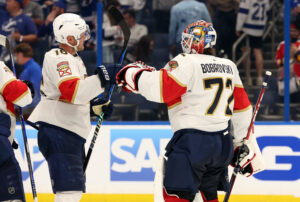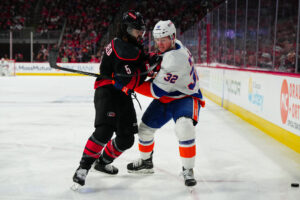The Stanley Cup Playoffs are officially set. For 16 teams, it must be a rush knowing that each has a shot to play for and get their name on the greatest chalice in the history of sports. However, 14 other clubs did not get this opportunity. While their seasons may be over, each of these teams has at least one positive that they can take from this season in terms of encouraging performances that they can build on for the 2017-18 campaign. Without further adieu, let’s begin with the 17th-ranked New York Islanders.
NOTE: All advanced statistics rankings are of players who have played a minimum of 700 minutes and are from corsica.hockey.
Every Non-Stanley Cup Playoff Team’s Most Encouraging Performances
New York Islanders
The Islanders may have found a finisher in 26-year old Lee to replace the offense left behind by Kyle Okposo when he signed with Buffalo. Before you say John Tavares was the only reason that he scored as many goals as he did, he factored in on 11 of his 34 total markers. Lee is not far removed from his 25-goal 2014-15 campaign, and his nine power play goals stood out on a team that was dreadful as a whole on the man advantage (28th, 14.9%). That 17.8% shooting percentage is a career high and ranked eighth overall in the league, but he was best on the team in getting his shots through traffic ranking first on the team in Fenwick-for percentage (52.88%) along with second best in overall shot attempts to Tavares. Per 60 minutes, he was best on the team in shots on goal (34.51).
Tampa Bay Lightning
Coming into this season, the #1 Lightning defenseman came off a rather disappointing year in 2015-16, scoring ten goals and 47 points. While those numbers are solid for any offensive defenseman, in 2013-14, his 13 goals and 55 points vaulted him into the select group of offensive blueliners. While 2014-15 was going the same way, injuries derailed what may have been a career season. This year needed to be the season that Hedman brought himself to elite status, and boy, did he. His 16 goals tied for third among defensemen and his 72 points were seven behind leader Brent Burns. In points per game, Hedman was right behind the Sharks blue liner as well with a .91 mark to place third. After just 11 power play points last season, all the Ornskoldsvik native did was lead the league with 33. Among all defensemen defensively, he ranked 16th in Corsi-against per 60 (51.25). It’s a shame that his season has gone under the radar with the Lightning missing the playoffs.
Philadelphia Flyers
After signing an eight-year, $66 million extension in the 2015 offseason, Voracek was expected to be a regular contributor for the Flyers coming off of his 22-goal, 81-point campaign and was paid as such. Instead, a serious dip in production was seen in 2015-16, scoring half the goals and just 55 points in 73 games. The dip in his power play contribution was a big key, scoring just one man advantage goal after 11 in his career year. Though he had just five 5-on-4 goals in 2016-17, it is encouraging to see Voracek put up points in another down year for the team offensively, as he lead the team in scoring with 61 points and scored more even strength goals (15) coming out to 20 in all 82 games played. He actually had a lower Corsi-for per 60 this year (58.72) than last year (60.44) and is taking roughly the same amount of shots per 60, so it could have been a case of being snakebitten. For production and confidence’s sake, it’s good to see Voracek scoring again.
Winnipeg Jets
The relative veteran on the club at 30 (one of six Jets past at or past this), Blake Wheeler has stayed on a model of consistency for years, sort of being the under the radar star with the star power in Patrik Laine and Mark Scheifele covering much of the top six. While chipping in offensively with three consecutive 26-goal seasons and back-to-back 70+ point campaigns, it’s incredible how good he is defensively on a team that gives up 31 shots per game (20th). Among forwards who have played a minimum of 700 minutes, he is 24th in terms of corsi-against per 60 (50.17), topping the team in Fenwick against, shots against, and expected goals against per 60. It will be important for a team that gives up as much as the Jets do to learn from Wheeler even if it means giving up some of their offense.
Carolina Hurricanes
While Sebastian Aho‘s rookie season was quite impressive and offers Carolina an important source of offense on the 21st-ranked goal-scoring team, what Skinner did this season was important on many levels, re-establishing himself as one of the games elite snipers. A subject of trade talks the past few seasons, his 37 goals scored (17 in the final 19 games) set a career high and he was a driving force behind Carolina’s late-season push to get into the postseason, with the team going 7-2-3 in the games he scored. His 63 points tied his Calder Trophy season total (career-high), and the most encouraging sign has to be the amount of shots he was able to generate (281, career-high). This came two seasons after an 18-goal, 31-point year in 77 contests. His scoring chances generated-for per 60 ranked 11th among all forwards (10.75). If you think he relied on Jordan Staal for all of his goals, Staal factored in on exactly two of them all season.
Los Angeles Kings
The Kings didn’t score much in 2016-17, ranking 25th (2.43 per game) in total offense. That didn’t deter Carter from having his best season since 2010-11 supplying 17% of the Kings’ goal output with 32 goals, nine of them game winners. He was fifth among all centers in Corsi-for per 60 and 37th among all forwards in shots for per 60 (33.77), third on the Kings in both categories. His 2.62 goals-for per 60 was .31 more than the next Kings skater, Dustin Brown, among skaters On the 15th-ranked power play his 10 markers and 22 points lead the unit. Though he scored just three goals in the final 27 games and the Kings missed the playoffs for the second time in three years, his consistency (three consecutive 24+ goal, 60-point seasons) is good to see as he delves into his 30s. The Kings will need all the offense they can get.
Florida Panthers
If anyone is going to replace the hands of Pavel Datsyuk, it’s Barkov. He missed 21 games and still nearly lead the Panthers in scoring with 52 points (21 goals). Not having Jonathan Huberdeau did affect his ending production, but by himself he is one heck of a talent. He may have been the one that thrived the most in head coach Tom Rowe‘s system, posting a 55.08% Corsi-for percentage to lead the team among players who suited up in 60 games. He was 22nd among all forwards in shots for per 60, at 34.77. The 21-year old Fin was the best defensive center up front for Florida, allowing 48.08 Corsi-for per 60. That mark is the tenth-best in the entire league among forwards and defensemen. A healthy season would do him and the Panthers well next season in their mission to get back to the postseason.
Dallas Stars
In a season where Valeri Nichushkin bolted for the KHL and injuries struck guys like Mattias Janmark, Patrick Sharp, Ales Hemsky, and Jiri Hudler up front, the Stars needed some help up on both sides of the puck to help out Jamie Benn and Tyler Seguin. Enter Roussel, one of the more underrated players in the game. He chipped in with 12 goals and 27 points (Fourth consecutive 12+ goal, 25+ point season) in just 60 games before his year was derailed by a hand injury in March. Beyond his scoring, he is a vital cog in the top nine, placing 15th among all forwards in Corsi-for per 60 (65.13) and lead the Stars in expected goals for per 60 (2.94). Leading the stars in Corsi-against per 60 (53.89), he was second-best in shots against per 60 (27.24), and third in expected goals against per 60 (2.46).
Detroit Red Wings
There are not many that believed Zetterberg had much to give entering a season that began with him turning 36. He was three years removed from back surgery and just looked plain slow in the second half of last season, scoring ten points in his final 26 games to the tune of a 13-goal, 50-point season, his worst in a season that he played 60+ games in since 2003-04. This year, his 68-point showing (17 goals) was the best since 2011-12 (22 goals, 69 points). His 35 primary assists (14 more than last season) ranked fourth in the entire league and his 1.89 helpers per 60 ranked tenth. What may be most impressive about this season for Zetterberg was how he got stronger as the season went on. In the final 26 games, he had 27 points, tied with Brad Marchand and Mathieu Perreault for sixth in the league over that span.
Buffalo Sabres
Growing as the campaign went on last year, it took Eichel a quarter of the season to get things rolling, scoring six goals and 10 points in his first 20 games en route to a respectable 24-goal, 56-point year. Unfortunately, his ankle injury before this past season caused him to miss the first 21 contests. All the 2015 “consolation-to-McDavid” pick did was pass tie his goal total and pass his point total (57) in 20 less games. His shot total of 249 was 11 more than last season’s ending total, and his 2.81 points per 60 slotted in at 21st among all skaters. The growth in the raw numbers is a great sign when he was a quarter of the season behind, especially at his age. If the Sabres can come back healthy next season in their top six, Eichel will be a driving force and difference in the team making a possible playoff push.
New Jersey Devils
Though the Devils were quite uninteresting again this season, Hall brought a sort of star power to the team when he was acquired in the Adam Larsson trade. His 20 goals and 53 points may have been his worst production of the three seasons he’s played in at least 70 games, but he was still the most consistent Devil in terms of generating some chances. He was the only Devil to fire 200+ shots on goal (238, 25th) and lead them in Corsi-for (57.14), Fenwick-for (44.36), shots for (32.77) and scoring chances for (8.73), all per 60 minutes. He will be a key cog offensively for them as they restock up front, and with more puck movers from the backend, his point totals should increase. On the other side of the puck, only Beau Bennett was better in Corsi-against per 60 up front (51.18), and in scoring chances against per 60, Hall lead the team in suppression (6.31).
Arizona Coyotes
Not many positives came from the Coyotes’ third consecutive bottom seven finish, but Dvorak was one of the few young players that provided glimpses of hope for the future. He was one of four Coyotes to score 15+ goals and finished fourth on the team in scoring (33 points) as a rookie. His five goals and 11 points ranked first and second respectively over the final 20 games. Offensively, he ranked third on the team in scoring chances for per 60 at 7.98. His 2.35 goals-for per 60 ranked second, and 1.98 goals-against per 60 ranked third on a team that gave up 3.15 goals per game and allowed 34.1 shots per contest.
Vancouver Canucks
Certainly a consideration for Canucks captain in the near future, Horvat enjoyed a career season that saw him lead Vancouver in goals (20) and points (52). It was the first time in ten years that someone not named Henrik Sedin or Daniel Sedin lead the team in points. He in fact, was the only 20-goal scorer on a team that finished second-to-last in overall scoring and last overall in shot generation. The London, Ontario native was one of the more exciting forwards, placing third on the team among his group up front in shots-for per 60 (27.93) and first overall in expected goals for at 2.50. This in turn, has lead to him generating the most scoring chances among his Vancouver forward teammates per 60 (8.53). With the Sedins on the twilight of their careers, the Canucks did receive some contributions from other young sources, but Horvat is a special case that has “C” written all over him as the Canucks trudge through a rebuild.
Colorado Avalanche
To say the Avalanche were bad this season is an insult to the word. Not all is lost, however, as the 10th overall pick in the 2015 draft proved to be quite the finisher on a team that was absolutely dreadful at scoring or doing really anything dangerous offensively. Playing with Nathan MacKinnon most of the time, he was able to crack 20 goals, the only Colorado player to do so. He was also one of two forwards, MacKinnon being the other, to post at least 10 power play points. The 20-year old also finished second to his linemate in Corsi-for (56.17), Fenwick-for (42.37), shots-for (31.38) and expected goals for (2.35). As the Avalanche start to tear down and rebuild, this duo could be a go-to one-two punch that pushes them over the edge, and it is big for Rantanen to produce now for individual confidence going forward despite where his team finished.
Main Photo:






